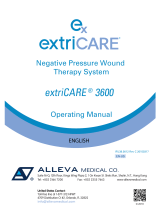Page is loading ...

Layer 1
Comfort Foam Layer
• Apply this layer
with the foam
side against the
skin, using just
enough tension
to conform to
the shape of the
leg with minimal
overlap.
• Cover the skin
with as thin a
layer as possible
with no gaps.
• When skin
folds (aprons)
are present,
use pieces of
comfort foam
layer folded with
foam side out to
separate them.
Step 1: With the foot in a 90˚ dorsiexed
position, start the application with a
circular winding at the base of the toes,
beginning at the fth metatarsal head.
Beginning at the fth toe provides
neutral, comfortable foot alignment.
Step 2: The second circular winding
should come across the top of
the foot so that the middle of the
bandage width approximately
covers the articulating aspect of
the ankle joint.
Step 3: Bring this winding
around the back of the heel
and lay it over the top of the
foot where it overlaps the
underlying material.
Step 4: Cut the wrap and
gently press into place.
The posterior plantar
surface of the foot is not
completely covered.
Step 5: With minimal overlap, and
with just enough tension to conform
smoothly along the contours, wind the
bandage around the ankle and proceed
up the leg applying the layer in the
direction the roll takes you.
Step 6: The top of the bandage should end just
below the bular head, or two ngers width
below the crease at the back of the knee. Bring
the bandage back down the leg to cover all areas
of the skin. To ensure as thin a layer as possible,
try to minimize the areas of overlapped material.
Step 7: As you end the application,
apply light pressure and cut o the
excess material. Mold the layers
together to ensure that the bandage
windings cohere to each other.
Layer 2
Compression Layer
• Apply the
material
at full stretch.
• Hold the roll
close to the limb
throughout the
application for
controlled, even
compression.
• If “bulges” are
noted after the
application,
apply additional
compression
layer until the
limb appears
smooth.
Step 8: With the foot in
90˚ dorsiexed position,
start the application
with a circular winding
at the base of the toes,
beginning at the fth
metatarsal head.
Step 9: Using the gure eight technique,
bring the roll back over the top of the foot,
across the bottom of the foot and back
up to come around the back of the heel.
Complete two or three gures of eight
around the ankle ensuring that the entire
heel is covered with at least two layers.
Cut the wrap and gently mold into place.
Step 10: Apply the next winding
by starting the roll at the previous
cut edge with a 50% overlap to the
underlying material. Bring the bandage
around the ankle and proceed up the
leg in the direction the roll takes you
with the top of the application ending
just below the bular head.
Step 11: Bring the
bandage back down
the leg to cover the
entire comfort layer with
at least two layers of
compression material.
Step 12: If at any time
you want to change the
direction of the roll, you
may cut the bandage and
redirect the application.
Step 13: As you end the
application, apply light
pressure and cut o the
excess material.
Step 14: Mold the layers
together to ensure that
the bandage windings
cohere to each other.
Critical & Chronic Care Solutions Division
3M Health Care
2510 Conway Avenue
St. Paul, MN 55144, USA
1-800-228-3957
3M.com/c3sd
3M and Coban are trademarks of 3M.
Please recycle. Printed in U.S.A.
© 3M 2011, 2015. All rights reserved.
70-2010-8238-8
Follow the Roll
Bandage
Removal
Remove with
bandage scissors
or by unwrapping.
Dipping the scissor
tips into body
lotion allows for
comfortable and easy
bandage removal.
NOTE: Refer to the Instructions for Use for
complete information related to the use of
3M
™
Coban
™
2 Layer Compression Systems.
Many patients have extreme leg contours. Due to the unique properties of 3M
™
Coban
™
2 Layer
Compression Systems, the application technique can easily be adapted to provide conformable,
eective, sustained compression. For patients less tolerant of compression, or who have mixed
etiology with an ABPI greater than or equal to 0.5, 3M
™
Coban
™
2 Layer Lite Compression System
is recommended.
3M
™
Coban
™
2 Layer Compression System Application
for a Highly Contoured Leg
/




